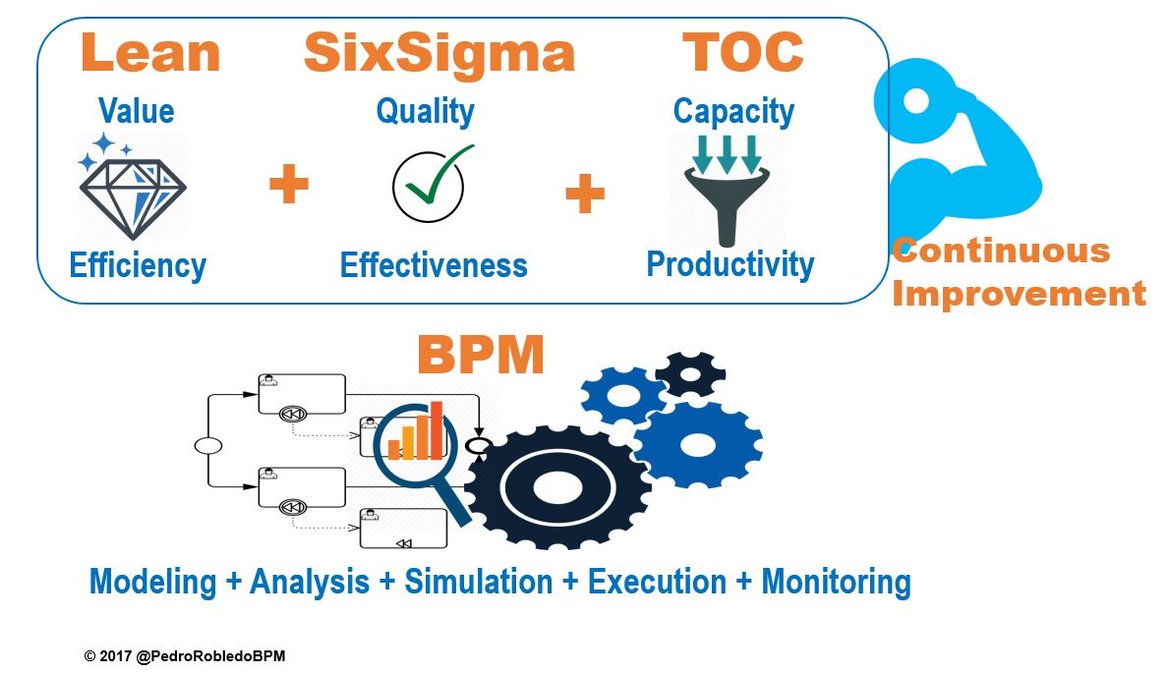¡HI! If you want to propose us a project, send a mail to info@albatian.com


ALL INFORMATION ABOUT
BPM, PROCESS, R & D, TECHNOLOGY
Lean+SixSigma+TOC provide methods for continuous process improvement in BPM
By: Pedro Robledo, BPM process management expert

The discipline of process management (BPM - Business Process Management) makes continuous improvement of any organization possible, by allowing to manage the business processes in an efficient and reliable way. When looking for the quality of an organization we are referring to achieving a degree of inherent characteristics that meets certain requirements, needs or expectations, looking for cost savings, more revenue, greater productivity, greater profitability, greater customer satisfaction, improved branding, motivation and engagement of employees, flexibility and preparation for the future, better respond to customers and business opportunities, improve the cycle time / speed, improve customer satisfaction, retention, and growth ...
These requirements, needs or expectations will become some business momentum in strategic objectives to achieve. Through BPM, companies can have modeling and design transversal processes to be able to manage a correct monitoring of the key indicators related to the objectives to be achieved and whether it is necessary to make the optimizations that facilitate achieving those strategic objectives.
In order to make a great qualitative and quantitative leap in the improvement of its processes and business resources, as well as to achieve true business agility, we must apply methodologies of continuous improvement that allow the optimization of the operational processes in a way that can achieve greater effectiveness , efficiency and performance in the execution of business oriented to obtain the results set.
Three continuous improvement methodologies (Lean, SixSigma and TOC) stand out, which are complementary, allowing to focus on different points of improvement of a process, and increase customer satisfaction by offering the required quality of the products in the right time and services.
Let's see the ones that offer the three methodologies of continuous improvement:
- LEAN: (named by James Womack for the management philosophy used by Toyota in the 1950s) is an improvement methodology that provides a way forward to continually improve efficiency (ability to achieve a certain effect by getting things right from the start) in the processes of manufacture or provision of the service. This is supported by the elimination within the productive process of everything that does not contribute value, allowing work in a more efficient and with a lower consumption of resources. In this way, immediate results are achieved in productivity, competitiveness and profitability of the business. A good approximation to the thinking of the Lean methodology to work on process improvement is the calculation of "Takt Time" (the average time between the start of production of one unit and the start of production of the next unit): the ratio that we need to produce to meet customer demands, and then balance the resources to this ratio. In Lean thinking, any capability in operations that is greater than the amount needed to meet customer demand will be considered a waste that will not produce value, so all Lean improvement initiatives will focus on eliminating such waste and in balancing capacity with demand.
- Six Sigma: (developed in 1985 by Bill Smith of Motorola) is an improvement methodology that provides a way to continuously improve the quality of the product or service, looking for cost savings, to increase customer satisfaction, to achieve 99.9999% effectiveness (ability to achieve desired or expected effect) and eliminate variability and waste. For this it focuses on reducing (to almost zero) defects (anything that does not meet customer requirements) and variations in processes, quality costs, cycle times and increase productivity and customer satisfaction at through the reduction of variations in products and processes to provide organizations with a sustainable competitive advantage over time. The Six Sigma methodology bases continuous improvement on two large indicators: the speed at which a process is performed (cycle time) and the number of errors that reach the customer (internal / external).
- TOC (Theory of Constraints): (created in 1970 by physicist Eliyahu M. Goldratt in his famous business novel "The Goal") is an improvement methodology that provides a way forward to continuously improve production capacity. This is based on attacking the restrictions or bottlenecks (which mark the rhythm of the processes) that limit the capacity of production processes. The objective of this theory is that companies make money for which it focuses on three process indicators: companies must maximize their sales (throughput - the process output minus the inputs of the process) - ensuring their presence in the market, reduce inventories (the cost of stockpiled materials) and minimize operational costs (the costs associated with transforming inventories into throughput), which includes direct, indirect and company costs.
Una de las principales herramientas para la mejora continua en las empresas es el conocido Ciclo Deming o también nombrado ciclo PDCA (Plan - planificar, Do -hacer, Check - verificar y Act – actuar) indicando que se deben llevar a cabo consecutivamente la secuencia lógica de esos cuatro pasos. Pero este ciclo se ha visto modificado por las metodologías Lean y SixSigma, definiendo un ciclo de cinco pasos, denominado DMAIC (Define - definir, Measure - medir, Analyze - analizar, Improve - mejorar y Control -controlar). Pero cuando queremos utilizar Lean+SixSigma+TOC+BPM debemos añadir dos pasos adicionales (SDMAICR): la selección de un proceso a mejorar al principio del ciclo y la reutilización de la mejora al final del ciclo. Veamos estas seis etapas: One of the main tools for continuous improvement in companies is the well - known Deming Cycle or also named PDCA cycle (Plan, Do, Check and Act) indicating that the logical sequence must be carried out consecutively of those four steps. But this cycle has been modified by the Lean and SixSigma methodologies, defining a cycle of five steps, called DMAIC (Define, Measure, Analyze, Improve and Control). But when we want to use Lean + SixSigma + TOC + BPM we must add two additional steps (SDMAICR): selecting a process to improve at the beginning of the cycle and reusing the improvement at the end of the cycle. Let's look at these seven steps:
- Select: Selection of the correct process to improve to achieve certain specific objectives.
- Define: Define the correct problem (inefficiencies -LEAN-, defects and variations - SixSigma and / or Bottlenecks - TOC), identifying the KPIs (key process indicators) related to the objectives to be achieved, as well as the limitations and exceptions of the process.
- Measure: Understand current process performance by monitoring KPIs and process information, identifying process variations, bottlenecks, and inefficiencies.
- Analyze: Determine the root causes of the problem, to identify what is wrong and what is causing unexpected variations and exceptions in the process. By means of the simulation of processes with historical data it is possible to detect root causes.
- Improve: Evaluate different solution alternatives to determine which is the most suitable for the searched improvement.
- Control: Check the correct operation of the selected alternative application, monitoring the KPIs.
- Realice: Replication and standardization of the successful implementation of the solution, in other business units, geographic areas, equipment ...
Lean, Six Sigma and TOC offer BPM continuous improvement methodologies to optimize business processes, and BPM provides the necessary capabilities (modeling, analysis, simulation, decision making, automated flows, task orchestration, KPI monitoring ...) to these methodologies to ensure that participants in a process are focused on value tasks by getting the productivity required to satisfy customers and achieve strategic objectives.
RELACIONADO
-
Process Digitalization in Digital Transformation
by Albatian Jan. 9, 2017
-
Agile, the last trend in information technology
by Albatian Feb. 19, 2017
-
Digital Transformation Life Cycle
by Albatian Nov. 14, 2016
-
Any Business Innovation and Transformation requieres an Enterprise Architecture
by Albatian March 27, 2017
-
BPM is key to the Digital Transformation
by Albatian Oct. 4, 2016
-
Not enough with an independent Management of a Process
by 4 May 9, 2017
-
BPM is the most effective discipline of business management
by Albatian Sept. 15, 2016
-
Differences between Processes, Procedures and Work Instructions
by 4 Dec. 7, 2017
-
Knowledge management and human component of BPM projects
by Albatian Feb. 19, 2013
-
¿BPMS for moments of crisis?
by Albatian Nov. 12, 2012











